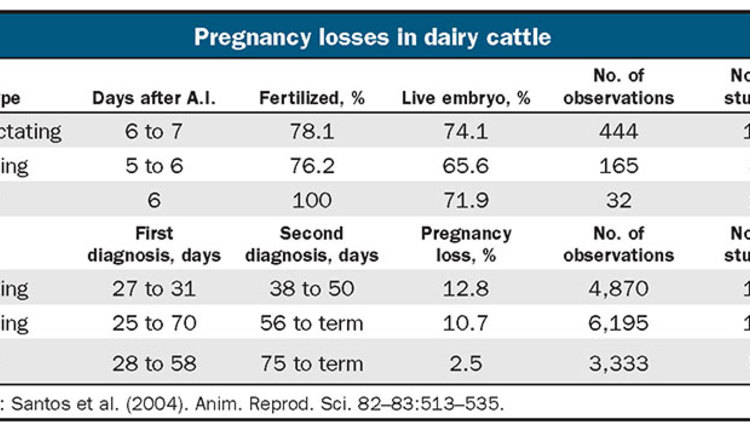Once conception occurs in every species, there is always a chance that the newly formed embryo will not survive to birth. Loss of pregnancy is frustrating and can occur at various stages of gestation and for a variety of reasons. These losses clearly produce a negative impact on the reproductive and economic performances of dairy herds. Let’s look at the time line for pregnancy loss in dairy cattle based on what is known in the scientific literature.
Four critical periods
During the first three months of gestation, there are four periods of pregnancy loss that occur. The first period occurs during the first week after A.I. breeding when fertilization fails or the early embryo dies in 20% to 50% of lactating dairy cows. Loss during this first week may be the result of poor egg quality caused by heat stress, inflammatory disease, body weight loss, body condition loss, or reduced progesterone concentrations during the period of preovulatory follicle development.
The second period encompasses Days 8 to 27 when the classical “maternal recognition of pregnancy” occurs. Losses during this period may average 30% but with surprising variation among farms (25% to 41%).
For pregnancy to continue, the corpus lutuem (CL) must be maintained by the embryonic signal interferon-tau and altered uterine secretory patterns of prostaglandins. There can be failures or delays in trophoblast (primitive placenta) elongation, embryonic development, or both, resulting in loss of pregnancy from poor support of uterine secretions . . . such as the histotroph . . . to nourish the growing embryo.
The third period is during the second month of pregnancy (Days 28 to 60). Losses during this time approach 12% based on a summary of more than 20,000 pregnancies in high-producing dairy cows (see table). The causes are generally twofold: delays or defects in development of the embryo or cotyledons (attachment of button-like structures that form on the placenta opposite the uterine caruncles), resulting in CL regression or embryo death.

Finally, a fourth period during the third month of pregnancy has small pregnancy losses (approximately 2%) when compared with the first three periods. However, rates can be elevated in some cows, particularly in those carrying twins in the same uterine horn.
Detection of losses
How can you manage these losses (see table) to maintain herd size and sufficient replacements?
Losses that occur during the first and second periods at less than 28 days of gestation are essentially nondetectable by any current on-farm technologies. Return to estrus in a normal window of Days 18 through 30 after last insemination may be evidence of fertilization failure or early embryo death (particularly those occurring after 21 to 22 days).
Diagnosis frequency
At least three pregnancy diagnoses should be made for each cow. The first earliest detection of pregnancy is the most important because you are identifying any open cow that needs to be promptly reinseminated. This first detection can be made by a positive blood or milk pregnancy-associated glycoproteins (PAG) test or ultrasound evidence of an embryonic heartbeat (Day 28 after insemination).
Blood and milk PAGs in pregnant cows climb from 25 days after insemination to an early peak at 32 days. Then they drop from 32 days to bottom out from 53 to 60 days after A.I. for the blood PAG assay and from 46 to 67 days for milk PAG assay. Concentrations of PAGs once again climb from 74 to 102 days after A.I. The optimal time to conduct a first pregnancy diagnosis is approximately 32 days after A.I., coinciding with an early peak in PAGs.
Because of the occurrence of pregnancy loss, all pregnant cows should be retested approximately 74 days after A.I. or later when plasma and milk PAG levels in pregnant cows have rebounded. When applying transrectal ultrasound or palpation, the next diagnosis should be approximately four to six weeks after the first positive test (60 to 80 days of gestation). This confirmation is important because of the embryo losses that occur during this period (the third period discussed previously; see table).
Overall, early pregnancy loss is greater in cows than in heifers. Early pregnancy loss is also greater in those cows inseminated or calving during spring or summer compared with those inseminated or calving during fall or winter.
A third diagnosis should be done at dry-off. The logic here is to ensure the cow is pregnant before applying immunizations or treatments that may have a meat withdrawal period, preventing immediate culling of an open cow.
A great importance
Maintaining good pregnancy rates are just as challenging and frustrating as preventing mastitis and improving milk production. Reducing heat stress, good preventive health programs, proper semen handling, good A.I. breeding techniques, and calving hygiene are just a few of the things you can do to reduce pregnancy losses. Happy A.I. breeding!







